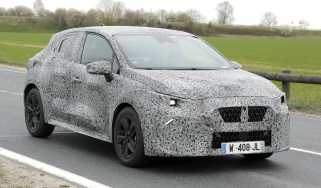MINI Cooper JCW
Hot Hatch
Sharp, agile and responsive – the MINI JCW has all the attributes that are needed to complete an emergency lane change. But how will it cope when we throw a simultaneous 70-0mph stop into the mix?
There’s certainly no doubting the MINI’s raw stopping power. In our first road test of the JCW, it achieved the best braking distance we’ve recorded for a hot hatch. And it excelled in our more extreme evasive test, too.
The MINI’s anti-lock system has a rapid and very efficient action, and the pedal remains reassuringly firm under foot. Better still, the stiff suspension set-up prevents dive under braking, and body movement is minimal.
The result is that the MINI changes direction and slows down well. Initial turn-in is very positive and braking strong throughout the lane-change manoeuvre. This combination of limpet like front-end grip and a stiff chassis means the MINI lifts its unloaded rear wheel through the lane change, but crucially this momentary loss of contact with the road doesn’t confuse or fluster the ABS system.
The MINI took 42.2 per cent longer to come to a halt in the lane change test compared to the straight-line stop. This increase is two-tenths of a per cent less than that recorded by the impressive BMW X6.
Used - available now

2023 Polestar
2
40,897 milesAutomaticElectric
Cash £19,500
2016 MINI
Countryman
63,700 milesAutomaticDiesel2.0L
Cash £9,000
2018 Audi
Q7
97,500 milesAutomaticDiesel3.0L
Cash £21,500
2015 Renault
Kadjar
68,521 milesManualDiesel1.6L
Cash £7,500The MINI’s standard stability control system can take much of the credit. It does a very good job of reining in the natural tendency towards a tail slide that you get in a front-wheel-drive model when you apply the brakes mid-corner.
From the driver’s seat, you can really feel the JCW’s electronics working by braking individual wheels to tug the car back into line. The MINI is equally impressive with the stability control turned off. It’s a testament to the chassis’s agility and adjustability that, without the system, a timely and accurate application of opposite steering lock balanced the car, corrected the slide and still brought the JCW to a halt in just over a metre longer than a stability control-assisted stop. However, without the reassuring help of the active safety system, it was harder to return to the original lane and make the finish gate.
Even so, the MINI’s body control, sharp steering and poise meant that with its active safety systems turned off, it was far more stable than the non-ESP equipped Ford Ka.
With brakes that are impressively resilient to fade – even after repeated emergency stops – the MINI’s set-up is easily a match for its straight-line performance and sharp handling. It just goes to confirm what a great hot hatch the JCW is.







